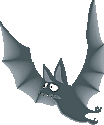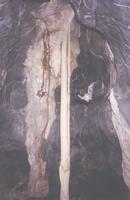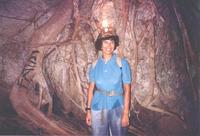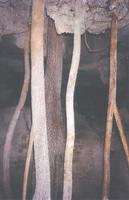|
As already mentioned on the Cave Fauna page, plants can't grow in caves as there is no sunlight. However some seeds do find their way into caves, they are either taken in with water, especially in times of flood, or else they are deposited in the bat droppings. They struggle to survive and are pale and spindly, and normally only reach a few cm in height before dying. So it was quite interesting to find these huge banana plants inside a cave in southern Thailand, obviously washed in by a flood. Also the coconuts which had got washed in and deposited on a ledge.

Bananas attemting to grow in total darkness, note the pale colour. These were found in a cave in south Thailand, and had been washed in by a flood. |
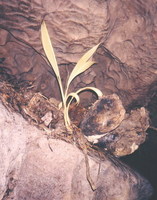
coconut seedling on a ledge about 3m above the floor |
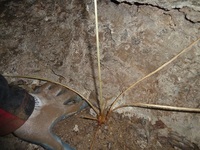
Unidentified plant deep in a cave in Merapoh, Gua Katak. |
Caves can be considered as low energy ecosystems. Guano supports this ecosystem by providing food for microorganisms and invertebrates and also a growth medium for fungi and microorganism. Some fungi normally grow on animal droppings, but other species will grow on animal bones, wood, and even the cave walls and floor.
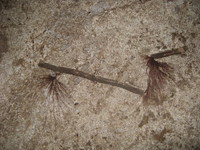
fungus growing on wood |

fungi growing inside the dark zone |
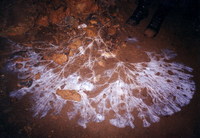
fungus in Gua Kelam 2 |
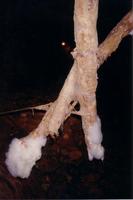
fungus on wooden prop |
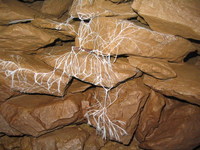
fungus growing in total darkness, Six Mile Tunnel |
Inside the cave, if there is electric lighting, various kinds of lampenflora may grow. These include mosses, algae and ferns. Lampenflora is a problem in some show caves in the vicinity of lighting fixtures. It is unsightly and may discolour the cave formations. Also the plants produce weak organic acids which in time can erode the cave limestone and formations. Lampenflora can be eliminated but needs to be done very carefully so as not to upset the cave ecosystem - details can be found on the internet.
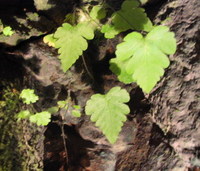
lampenflora |
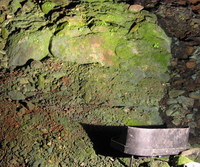
lampenflora in Gua Tempurung |
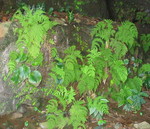
ferns found within twilight area of the cave |
Large roots sometimes come into caves, seeking moisture.
Some limestone flora found outside caves
Various plants are found in and around cave entrances, many of these are endemic to limestone. Some of the more common are the monophyllaea, these are single leafed plants, and can be more than 50 cm long. More than 20 species are found on Malaysian limestone hills. There are also many types of balsams (e.g. impatiens sp.), begonia, chiritas and paraboeas which grow on limestone. Some ferns can grow on limestone. Limestone hills support a special type of flora such as the characteristic small herbs. Examples of these herbs include a Senyumia sp. from Gunung Senyum, and a Speleanthus sp., found at hills such as Gua Bama and Batu Luas in Pahang. Gunung Senyum and Gunung Jebak Puyuh in Pahang are home to an endangered begonia Senyumia minutiflora, but the latter hill is being likely to be quarried.
I have seen aroids from Batu Niah being sold by Malaysian sellers on Ebay.
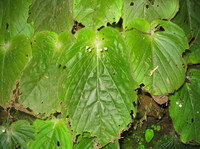
monophyllaea |
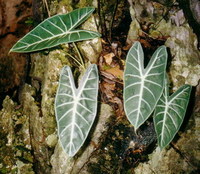
aroid Alocasia longiloba |
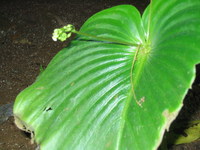
monophyllaea Dark Cave |
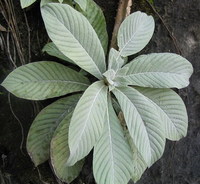
paraboea |
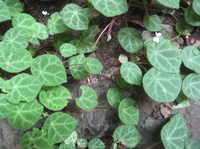
Begonia, Pahang |
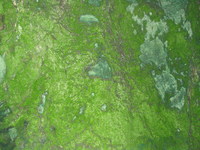
moss outside Dark Cave |
According to the Forest Research Centre in Sarawak, limestone forest is one of the eight major forest types. These limestone forests can range from sea level up to high altitude mountains, such as Gunung Api (1682m) and Gunung Benarat in Mulu. Gunung Api is famous for its pinnacles, which have vegetation at their base. Limestone forests can support dipterocarps.
Many species of limestone flora are endemic or are only found on limestone. Limestone hills provide microhabits in confined areas, but the flora is often vulnerable due to the small area it occupies. The drier parts of the hills may periodically suffer from drought and possibly fires. The vegetation may also be disturbed by humans, through logging, quarrying, mineral extraction from intrusive rocks, clearing and burning, land development and by collection for horticulture.
Cycads are found on some limestone hills. Cycads are the oldest group of seed-bearing plants and have undergone relatively very little change over the last three hundred million years or so, earning them the euphemism of living fossils. It is thought there are three species of cycad from the genus Cycas in Malaysia. Cycas clivicola grows on limestone hills (clivicola means cliff dweller), and is on the IUCN Red List of threatened species.
Read more about cycads in Conservation Malaysia.
Unfortunately cycads are endangered due to indiscriminate collection, see Threats page.

© Liz Price 2004-2012
Last updated 4 Dec 2012
|
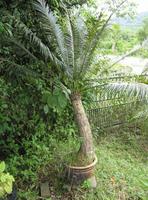
Cycas |
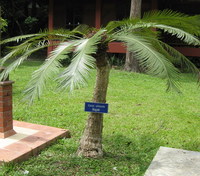
cycas |
|
